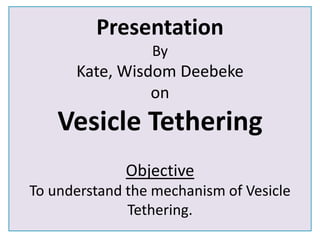''VESICLE TETHERING'' Presentation By KATE, Wisdom Deebeke
- 1. Presentation By Kate, Wisdom Deebeke on Vesicle Tethering Objective To understand the mechanism of Vesicle Tethering.
- 2. Vesicle Tethering, what is it? ŌĆó Formation of physical links between v- and t-SNARES ŌĆó Formed before TRANS SNARE complex formation ŌĆó Aimed at promoting specificity between two membranes ŌĆó Growing number of factors involved now identified, all recruited by Rab GTPase.
- 3. Tethering factors Two broad classes of molecules identified: a) Long coiled-coil proteins ŌĆó Form homodimeric coiled-coils ŌĆó E.g. Uso1p (in yeast) and P115 (in mammals) ŌĆó Essential for tethering ER-derived vesicles b) Multisubunit tethering complexes ŌĆó 7 large conserved complexes proposed ŌĆó Initially identified in yeasts ŌĆó E.g. include exocyst, COG complex, TRAPP, etc. ŌĆō TRAPP-1 involved in ER-Golgi anterograde transport Image from: Whyte, J. R. C. and S. Munro (2002). "Vesicle tethering complexes in membrane traffic." Journal of Cell Science 115(13): 2627-2637.
- 4. Summary ŌĆó Vesicle tethering important for specific localisation of transport vesicles on membranes ŌĆó Many factors involved have been identified and characterised ŌĆó Rab GTPase plays important role in Tethering factor recruitment References: 1. Whyte, J. R. C. and S. Munro (2002). "Vesicle tethering complexes in membrane traffic." Journal of Cell Science 115(13): 2627-2637 2. Olkkonen, V. M. and E. Ikonen (2006). "When intracellular logistics fails - genetic defects in membrane trafficking." Journal of Cell Science 119(24): 5031-5045.
- 5. THANK YOU FOR YOUR ATTENTION ANY QUESTIONS...?





